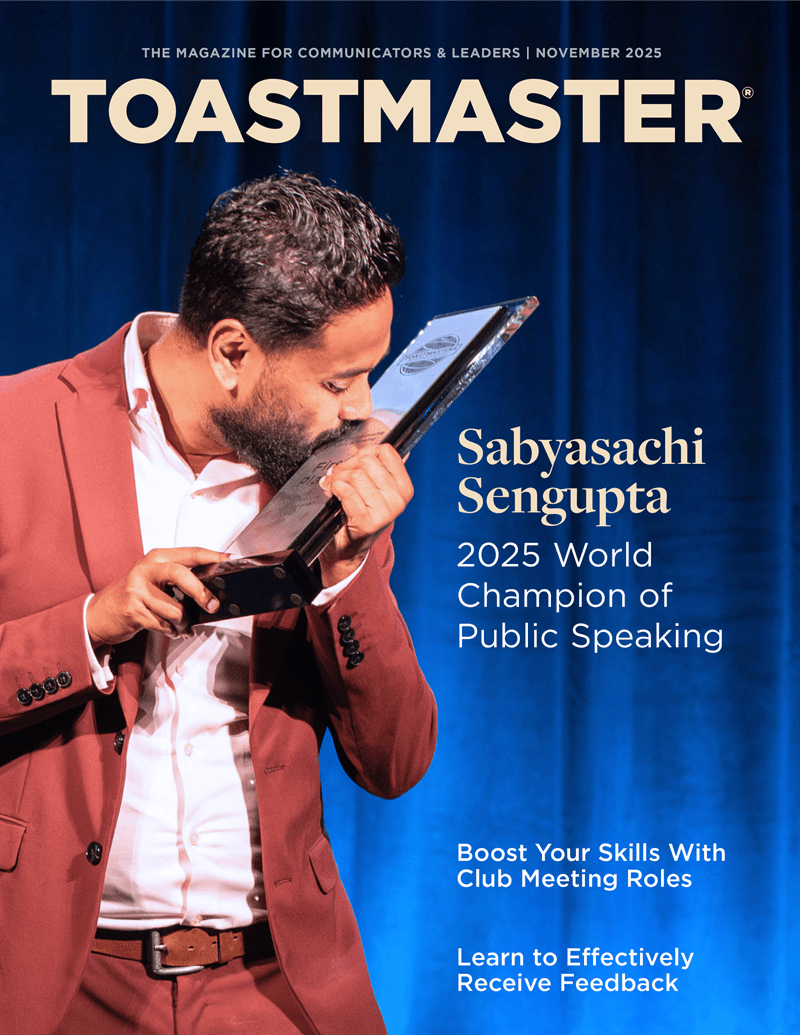
What do the phrases “I want to learn more” and “The ideas are inspiring” have in common? They are both evaluations of a Toastmasters speech that address the content of the talk. What speakers say is as important and impactful as how they say it.
A new speaker often has questions on how to organize material into a cohesive and interesting presentation. Few speakers can write an “I Have a Dream” speech, but each of us can put together a talk that is understandable, meaningful and relatable to the listener. It is a challenge we can all overcome.
A good speech relies on two basic concepts: 1) The construction—the speech’s building blocks of beginning, middle and end—must be consistent. It contains at least one thread that runs throughout the talk that ties the parts together as a whole. 2) The content—whether it is a personal story or a quote—creates a connection. Listeners respond to content that is relatable or of personal value.
Here are five easy tips to ensure that people who are new to public speaking can meet these two basic concepts with aplomb:
1. Make your introduction relevant to the rest of the speech. The introduction is an opportunity to tickle curiosity and generate excitement. It creates anticipation about what listeners expect they will learn. The audience is listening for the connection between the opening and the rest of the message. If we don’t provide that, we risk leaving the audience confused.
2. Aim for simplicity. A good story has a beginning, middle and an end. Remember that it’s often that simple. It is much easier to tie those components together with a few main points, without an abundance of detail. A typical club speech of five to seven minutes provides a perfect window of time to make a few solid key points before the audience succumbs to instinctive thought-wandering. Fewer details can have a much greater impact than too many.
“Listeners respond to content that is relatable or of personal value.”
An audience’s naturally short attention span is actually an advantage for the speaker. A few substantiated facts should be enough to garner credibility—you do not have to be “the expert” on the topic you are presenting. An added bonus: You do not have to spend arduous time over-researching your topic.
3. Rely on your own voice and wisdom. Building a story becomes much easier when the topic is familiar or important to you. If you normally do research for your vocation or avocation, pick a topic you find comfortable or compelling. If something has piqued your interest, pursue it. If experience has taught you a lesson, share it. An audience is apt to relate to a speech that has commitment and passion behind it.
4. Include something personal in the talk. People love stories, particularly personal ones. Science suggests the brain is wired to listen for—and respond to—stories. Audiences connect to speeches that have heartstrings attached.
5. Relate the conclusion back to the introduction. A good conclusion ties up all loose ends for your audience. Listeners feel a sense of comfort and completion when a speaker offers an idea, follows through with information and finishes by solidifying the takeaway. Connect back to your introduction with a call to action, an upbeat ending, a surprise or a parting quote. The conclusion is likely to be the most memorable part of the speech and is what your typical listener will recall.
These basic guidelines help new speakers create an attention-holding talk that builds experience, confidence and a new comfort level with audiences. In fact, these tips are largely timeless and will help speakers hone public speaking skills, whether you’re a novice or a seasoned Toastmaster.
Judith T. Krauthamer is the author of four books and is a certified life coach specializing in mindfulness. She is the vice president public relations for the APL Toastmasters club in Laurel, Maryland. Visit her website for more information.



 Previous
Previous
 Previous Article
Previous Article

